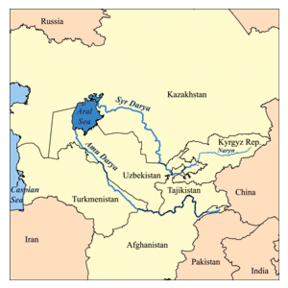Kyrgyzstan

Kyrgyzstan is a country located in Central Asia. Landlocked and mountainous, Kyrgyzstan is bordered by Kazakhstan to the north, Uzbekistan to the west, Tajikistan to the southwest and China to the east. Its capital and largest city is Bishkek.
Origin of name
"Kyrgyz" is believed to have been derived from the Turkic word for "forty", in reference to the forty clans of Manas, a legendary hero who united forty regional clans against the Uyghurs. Literally it means We are forty. At the time, in the early 9th century AD, the Uyghurs dominated much of Central Asia (including Kyrgyzstan), Mongolia, and parts of Russia and China.[1]
History
According to David C. King, "Scythians were early settlers in present-day Kyrgyzstan"[2]
According to recent historical findings, Kyrgyz history dates back to 201 BC. The early Kyrgyz lived in the upper Yenisey River valley, central Siberia (see Yenisei Kirghiz for details).
As early as the 7th century, Turkic traders introduced Islam to Central Asia, including what is now Kyrgyzstan, through doing business with Arabic people. The Kyrgyz state reached its greatest expansion after, under the leadership of Jordan the Superior, defeating the Uyghur Khaganate in 840 A.D. Then the Kyrgyz quickly moved as far as the Tian Shan range and maintained their dominance over this territory for about 200 years.
In the twelfth century, however, the Kyrgyz dominion had shrunk to the Altay Range and Sayan Mountains as a result of the Mongol expansion. With the rise of the Mongol Empire in the thirteenth century, the Kyrgyz migrated south. The Kyrgyz were conquered by Genghis Khan in 1207.
Chinese and Muslim sources of the 7th–12th centuries AD describe the early Kyrgyz as red-haired with white skin and blue eyes, which is indicative of ancient Iranic mountain tribes like the Pamiri people or Dardic people.[3][4] The descent of the Kyrgyz from the autochthonous Siberian population is confirmed on the other hand by the recent genetic studies.[5] Because of the processes of migration, conquest, intermarriage, and assimilation, many of the Kyrgyz peoples that now inhabit Central and Southwest Asia are of mixed origins, often stemming from fragments of many different tribes, though they now speak closely related languages.[6][7]
Issyk Kul Lake was a stopover on the Silk Road, a land route for traders, merchants and other travelers from the Far East to Europe.
Kyrgyz tribes were overrun in the 17th century by the Mongol Oirats, in the mid-18th century by the Manchu Qing Dynasty, and in the early 19th century by the Uzbek Khanate of Kokand.[8]
Rivers of Kyrgyzstan
The list of Rivers of Kyrgyzstan include: Ala-Archa River, Alabuga River, At-Bashi River, Chatkal River, Chong-Kemin River, Chu River, Kara Darya, Kara-Suu, Kegart River, Kichi-Kemin River, Kochkor River, Kökömeren River, Kurshab River, Naryn River, Sokh River, Talas River, Tar River (Kyrgyzstan), Toshkan River, Vakhsh River, Ysyk-Ata River,
External links
References
- ↑ ARTICLES AND INFORMATION/MANAS: THE KYRGYZ ODYSSEYS, MOSES, AND WASHINGTON
- ↑ King, David C (2005-09). Kyrgyzstan. Marshall Cavendish. p. 144. ISBN 0-7614-2013-4.
- ↑ V.V. Bartold, The Kyrgyz: A Historical Essay, Frunze, 1927. Reprinted in V.V. Bartold, Collected Works, Volume II, Part 1, Izd. Vostochnoi Literatury, Moscow, 1963, p. 480 (Russian)
- ↑ Mirfatyh Zakiev, Origins of the Turks and Tatars, Part Two, Third Chapter, sections 109–100, 2002. Retrieved on 15 May 2009
- ↑ The Eurasian Heartland: A continental perspective on Y-chromosome diversity
- ↑ "Kyrgyzstan". Encyclopædia Britannica. 2010.
- ↑ Tatjana Zerjal et al. (2002). "A Genetic Landscape Reshaped by Recent Events: Y-Chromosomal Insights into Central Asia". The American Journal of Human Genetics 71 (3): 466–482. doi:10.1086/342096. PMC 419996. PMID 12145751.
- ↑ "Kyrgyzstan–Mongol Domination" Library of Congress Country Studies.
Back to Places

